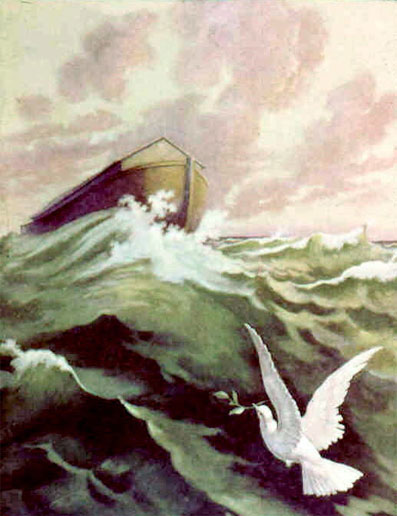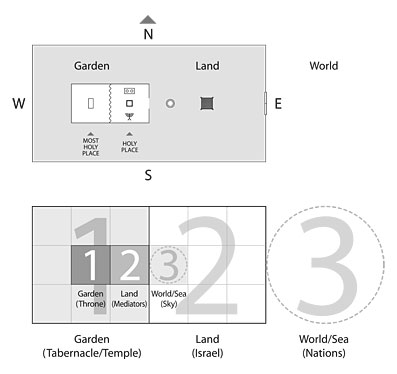Trinitarian Judgments

If we don’t get Genesis right, we’ll get much of the Bible wrong. In Through New Eyes (PDF), James Jordan identifies a three-level “cosmos” in the Creation, which is reflected on the earth. There is the Garden Sanctuary, the Land of Eden, and the Outlying Lands, or Garden, Land and World.
This is reflected, not only in the ark of Noah, but also in the Tabernacle. The image is dual, one in heaven and one on earth:
Heaven: The Most Holy Place (God), the Holy Place (Angelic Mediators) and the Laver (Crystal Sea).
Earth: The Tabernacle (God), the Bronze Altar (Israel), and the Gentiles (Sea of Nations)
I can’t quite get my head around the relevant diagrams in Through New Eyes, but here’s how I see it, with a diagram from my book.

Garden, Land, World corrpespond to Father, Son and Spirit. In Genesis 1-6, the three territories are corrupted. Jordan writes:
Man’s first fall, in the Sanctuary, prevented his going into Eden and resulted in his being put in a Homeland that was not a Throneland. The second fall, of Cain, expelled him from a Homeland into a world of wandering. The third fall, of the Sethites, removed the sinners from the world through the great flood.
…these rebellions constituted stealing the gift of the Father (sacrilege), murder of the brotherhood of the Son (fratricide), and resisting the marital gifts of the Spirit (intermarriage or compromise).[1]
An understanding of this pattern is crucial when it comes to Bible prophecy. But it undergirds some other areas that are very familiar. For instance, Jordan observes that Jesus was condemned at the house of the High Priest (Most Holy – Garden), then by Herod (Holy Place – Land), and then by Pilate (Court – World). In fact, Pilate washes his hands of the incident in a Laver.
Paul was also judged at the house of Ananias the High Priest, by the Chief Priests and Elders, and then by Felix the Governor.
Well, that’s background. My point is that this pattern solves the question of the timing of the second coming of Christ. I believe that the texts that imply an imminent coming should be taken as imminent. This is not how most “partial preterists” think, and the full preterists are right to point out their inconsistent hermeneutic. But if all was fulfilled in AD70, the full preterists have to deny a future judgment, and redefine the meaning of the last enemy, death. And I am right with the partial preterists on the consequences of this subtle shift. It can lead to many other heresies, including gnosticism and universalism. The only other solution is to propose that Christ’s coming was imminent, but it was postponed. This is not how God works. Judah was divided in two in history in AD70, as Jesus promised. The Covenant curses fell upon Israel for the last time. That is exactly what all the “comings” in the Old Testament are like.
“So I have come down to deliver them out of the hand of the Egyptians, and to bring them up from that land to a good and large land, to a land flowing with milk and honey, to the place of the Canaanites and the Hittites and the Amorites and the Perizzites and the Hivites and the Jebusites.” Exodus 3:8
Any complaint about Jesus not “coming down” visibly in AD70 is ignorant of the Old Testament, or at least applying a different hermeneutic to the New. He came down just as he did to judge Nimrod’s tower (Genesis. 11:7), but it was Herod’s Babylon.
For me, the solution is that Jesus as Adam was judged in the Garden by the Father (for Adam’s sacrilege):
“Now is the judgment of this world; now the ruler of this world will be cast out.” John 12:31
Judah was judged in the Land by the Son (right across the oikoumene) for the sin of fratricide (and note that all the innocent blood shed from Abel fell upon that generation:
“that on you may come all the righteous blood shed on the Land, from the blood of righteous Abel to the blood of Zechariah, son of Berechiah, whom you murdered between the temple and the altar.” Matthew 23:35
“from the blood of Abel to the blood of Zechariah who perished between the altar and the temple. Yes, I say to you, it shall be required of this generation.” Luke 11:51
“By faith Abel offered to God a more excellent sacrifice than Cain, through which he obtained witness that he was righteous, God testifying of his gifts; and through it he being dead still speaks.” Hebrews 11:4 (in the context of Hebrews being an urgent seismic alert to all the “tribes of the Land” (Rev. 1:7)).
“…to Jesus the Mediator of the new covenant, and to the blood of sprinkling that speaks better things than that of Abel.” Hebrews 12:24
With both the Garden and Land purged and replaced with new worship and new mediators (a heavenly human government), what remains is the end of the New Covenant, the judgment of all nations after a final rebellion described in Revelation 20. The pattern says this should be a judgment by the Spirit but we never read of judgment by the Spirit, only conviction of judgment (John 16). The Spirit builds the church. He is the mortar of true Babel, the empowerer. The final judgment will be carried out under Father and Son by the Church.
“Do you not know that we shall judge angels? How much more, things that pertain to this life?” (1 Cor. 6:3)
These three judgments correspond to the missions of Noah’s dove. After the first recce, the world is still formless. After the second, the Spirit carries the Branch (totus Christus), and after the third, the Dove-city finally finds a clean place to rest her foot. She takes Dominion over Garden, Land, World, and the earth is finally, truly, a Tabernacle for God. [2]
____________________________________
- James B. Jordan, The Production of the New Testament Canon: A Revisionist Suggestion, BIBLICAL HORIZONS No. 56, www.biblicalhorizons.com
- See also Three Resurrections.

























